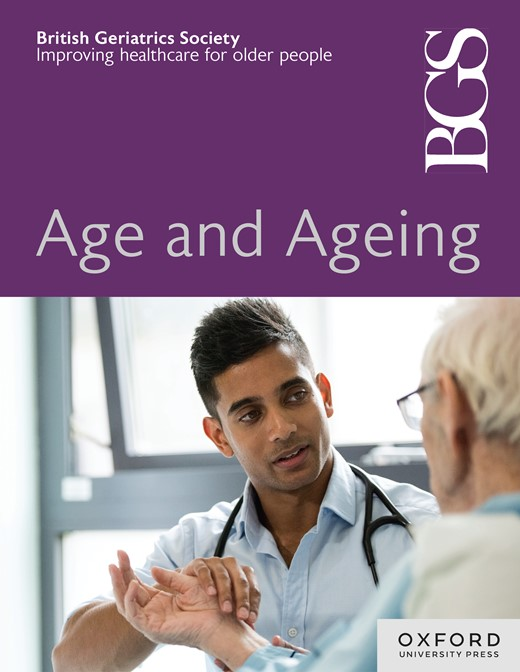3088 Can the length of stay on intermediate care units (ICUs) be reduced for non-weight bearing patients?
IF 7.1
2区 医学
Q1 GERIATRICS & GERONTOLOGY
引用次数: 0
Abstract
Introduction Fragility Fractures can lead to immediate complications, decline in health status, increase in hospital stay, increased care needs and reduction in the quality of life (Court-Brown C Clement N, Duckworth A, The Bone and Joint Journal, 2014 96-B(3) 366–372). However, the National Osteoporosis Society (2017) reported 80% of non-hip fractures were not offered strength or balance exercises It is estimated that fragility fractures cost the UK £4.4 billion which includes £1.1 billion for social care (Office for Health Improvement & Disparities, 2022). At Sussex Community NHS Foundation Trust, non-weight bearing (NWB) patients have prolonged bed-based stays. Complex patients cannot be discharged home when NWB as there is no commissioned social care pathway. These patients are seen as low priority for rehabilitation. The aim of the project was to reduce the length of stay for NWB orthopaedic patients. Method Baseline data of 10 inpatients from the Sussex Community NHS Foundation Trust ICU, discharged in April 24 was scrutinised. The team articulated the issues for NWB in a fishbone diagram, and a tailored programme of resistance strengthening and balance exercises was introduced for 8 NWB patients in May and June 2024, as a PDSA cycle. This included leg ankle weights and dumbbells to carry out chair and standing exercises (when appropriate), in addition to routine group physiotherapy sessions. All patients were seen 2–3 times a week. Results The average length of stay for NWB patients reduced by 14 days. The number of therapy contact sessions reduced to 2.1 post orthopaedic review and patients were weight bearing again. Conclusion Providing a tailored strengthening exercise programme that focuses on the non-weight bearing phase of the patient’s orthopaedic rehabilitation journey reduced the length of stay on the intermediate care unit, and the physiotherapy interventions once weight bearing.3088非负重病人在中间护理病房的住院时间可否缩短?
引用本文易损性骨折可导致即刻并发症、健康状况下降、住院时间延长、护理需求增加和生活质量下降[j] .中华骨关节杂志,2014,96-B(3): 366-372。然而,国家骨质疏松症协会(2017年)报告称,80%的非髋部骨折患者没有进行力量或平衡锻炼。据估计,脆性骨折花费了英国44亿英镑,其中包括11亿英镑的社会护理费用(健康改善办公室& &;差距,2022)。在苏塞克斯社区NHS基金会信托,非负重(NWB)患者有长期的卧床治疗。由于没有委托的社会护理途径,复杂的患者不能在NWB时出院回家。这些患者被视为康复的低优先级。该项目的目的是减少NWB骨科患者的住院时间。方法回顾性分析4月24日苏塞克斯社区NHS基金会信托ICU住院患者10例的基线资料。研究小组在鱼骨图中阐明了NWB的问题,并于2024年5月和6月为8名NWB患者引入了量身定制的阻力增强和平衡练习计划,作为PDSA周期。这包括腿部脚踝重量和哑铃进行椅子和站立练习(适当时),除了常规的团体物理治疗课程。所有患者每周2-3次就诊。结果NWB患者平均住院时间缩短14天。骨科检查后治疗接触次数减少到2.1次,患者再次负重。结论:在患者骨科康复过程的非负重阶段提供量身定制的强化锻炼方案,减少了患者在中间护理单元的停留时间,减少了负重后的物理治疗干预。
本文章由计算机程序翻译,如有差异,请以英文原文为准。
求助全文
约1分钟内获得全文
求助全文
来源期刊

Age and ageing
医学-老年医学
CiteScore
9.20
自引率
6.00%
发文量
796
审稿时长
4-8 weeks
期刊介绍:
Age and Ageing is an international journal publishing refereed original articles and commissioned reviews on geriatric medicine and gerontology. Its range includes research on ageing and clinical, epidemiological, and psychological aspects of later life.
 求助内容:
求助内容: 应助结果提醒方式:
应助结果提醒方式:


